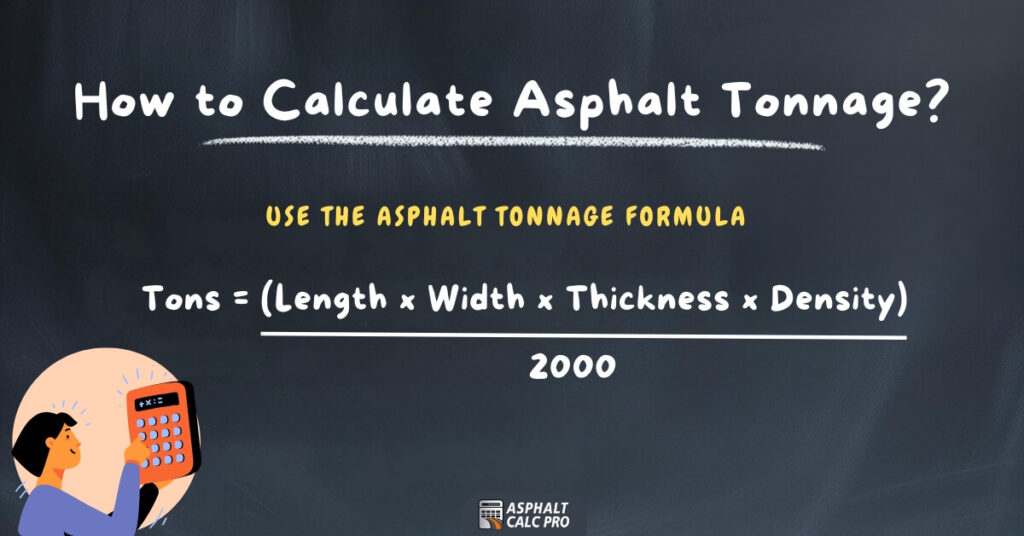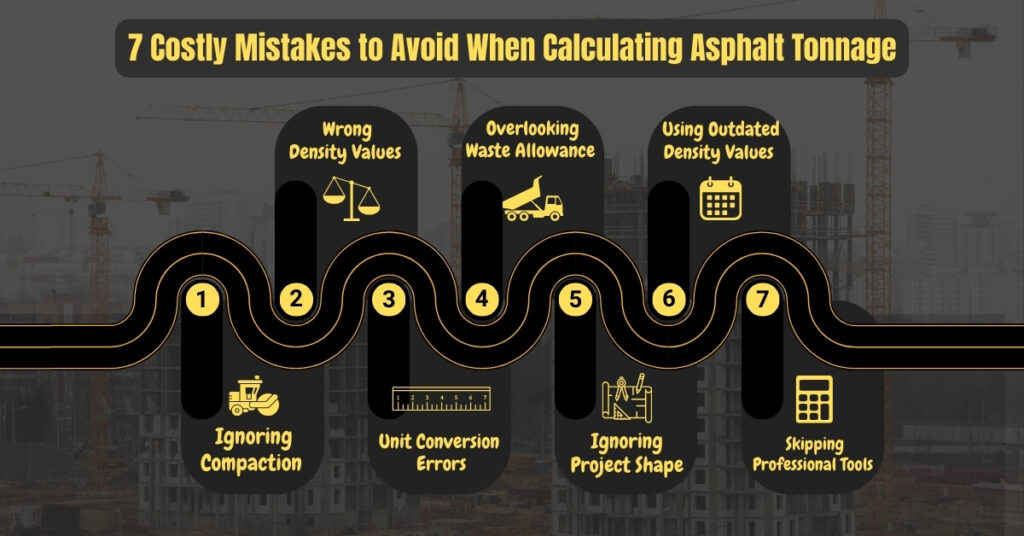Knowing how to calculate asphalt tonnage is important for any paving job. The Ultimate Guide to Calculating Asphalt Tonnage If you’re paving a driveway, parking lot, or road, use this guide to calculate tonnage like a pro. Discover how to calculate Ashpalt Inventory including the formula, step-by-step examples, common mistakes to avoid, and our free Asphalt Tonnage Calculator to ensure your results are accurate.
![Flat lay image featuring a tape measure, calculator, and various asphalt samples arranged around the text 'HOW TO CALCULATE ASPHALT TONNAGE IN 3 EASY STEPS [2025]'. The bottom left corner includes the 'Asphalt Calc Pro' logo.](https://asphaltcalcpro.com/wp-content/uploads/2025/03/Learn-how-to-calculate-asphalt-tonnage-in-3-easy-steps-for-your-paving-project-1024x536.jpg)
What is Asphalt Tonnage?
Asphalt tonnage is the weight of asphalt in tons that is needed for a project. It’s determined by three principal factors:
- Area: Length × Width (in feet).
- Thickness: Depth of asphalt (in inches).
- Density: Weight per cubic foot (lbs/ft³), which varies by asphalt type.
For instance, a 1,000 sq ft driveway at a 4-inch thickness requires about 26 tons of asphalt, with waste allowance.
Why Calculate Asphalt Tonnage?
Accurate asphalt tonnage calculations play an important role for:
- Budgeting: Avoid over- or under-ordering materials as well as help with budgeting.
- Project Planning: Ensure No Delays in Completion.
- Cost Efficiency: Order exactly what you need and save!
If you’re interested in how to calculate asphalt tonnage, the next section explains it.
How to Calculate Asphalt Tonnage?
When you know how to calculate asphalt tonnage, you’ll discover it’s a relatively simple task.

How to Calculate Asphalt Tonnage in 3 Steps If you’ve asked yourself how to figure asphalt tonnage, it’s much less complicated than you would expect. Begin by measuring the length, width, and height of your area of project.
Professionals use the following formula:
Tons = (Length (ft) × Width (ft) × Thickness (in) × Density (lbs/ft³)) ÷ 2000
This formula shows how to calculate asphalt in tons for any project size or shape.
Here’s how it works:
- Length & Width: Take your project area measurement in feet.
- Thickness: Convert inches to feet (divide by 12).
- Density: Correct value according to asphalt type (See Asphalt Density Chart below)
- 2000: Converts pounds to tons (1 ton = 2000 lbs).
For example, if you’re paving a 1,000 sq ft driveway with 4-inch thick hot mix asphalt:
- Convert thickness: 4 inches ÷ 12 = 0.33 ft.
- Calculate volume: 1,000 × 0.33 = 330 ft³.
- Apply density: 330 × 145 lbs/ft³ = 47,850 lbs.
- Convert to tons: 47,850 ÷ 2000 = 23.9 tons.
- Add waste allowance: 23.9 × 1.10 = 26.3 tons.
Before we jump into those step-by-step examples though, it’s important to understand why how to calculate asphalt tonnage is something to care about. Ensuring that you make precise calculations avoids over-ordering that wastes money or under-ordering that stuns your project. Knowing how to calculate asphalt in tons will help keep your project on track from the beginning to the end.
Step-by-Step Examples: How to Calculate Asphalt in Tons
Example 1: Residential Driveway (1,000 sq ft)
- Convert Thickness: 4 inches ÷ 12 = 0.33 ft.
- Calculate Volume: 1,000 sq ft × 0.33 ft = 330 ft³.
- Apply Density: 330 ft³ × 145 lbs/ft³ = 47,850 lbs.
- Convert to Tons: 47,850 ÷ 2000 = 23.9 tons.
- Add Waste Allowance: 23.9 × 1.10 = 26.3 tons.
Example 2: Commercial Parking Lot (10,000 sq ft)
- Convert Thickness: 6 inches ÷ 12 = 0.5 ft.
- Calculate Volume: 10,000 sq ft × 0.5 ft = 5,000 ft³.
- Apply Density: 5,000 ft³ × 145 lbs/ft³ = 725,000 lbs.
- Convert to Tons: 725,000 ÷ 2000 = 362.5 tons.
- Add Waste Allowance: 362.5 × 1.10 = 398.8 tons.
Example 3: Road Repair (500 sq ft)
- Convert Thickness: 3 inches ÷ 12 = 0.25 ft.
- Calculate Volume: 500 sq ft × 0.25 ft = 125 ft³.
- Apply Density: 125 ft³ × 135 lbs/ft³ = 16,875 lbs.
- Convert to Tons: 16,875 ÷ 2000 = 8.4 tons.
- Add Waste Allowance: 8.4 × 1.10 = 9.2 tons.
Asphalt Density Chart
| Asphalt Type | Density (lbs/ft³) | Best For |
|---|---|---|
| Hot Mix Asphalt (HMA) | 142-148 | Driveways, Roads |
| Cold Patch Asphalt | 130-138 | Emergency Repairs |
| Recycled Asphalt (RAP) | 125-135 | Eco-Friendly Projects |
Everyone learning how to calculate asphalt tonnage will need an Asphalt Density Chart. Density varies by the type of asphalt and consequently affects the tonnage needed.
For example, hot mix asphalt (HMA) is denser than recycled asphalt (RAP), so you will require more tons of HMA to cover the same space. Remember, always refer to the density chart when determining how exactly you’re going to calculate asphalt tons.
Source: Asphalt Institute
7 Costly Mistakes to Avoid When Calculating Asphalt Tonnage
If you do not follow the right process, you will end up making expensive mistakes — even when you know how to calculate asphalt tonnage. When the takeoff process is performed manually, it can be error-prone, resulting in incorrect estimates, wasted materials, and project delays.

Knowing how to calculate asphalt in tons and having an idea of some common mistakes to avoid can save you time, money, and effort.
- Ignoring Compaction: Asphalt 15-20% volume lost to compaction. Always take your total and multiply it by 1.15-1.20.
- Wrong Density Values: Using a density value for a hot mix project that is representative of a cold mix project will create errors. Verify material specs.
- Unit Conversion Errors: Using inconsistent units such as inches and feet or pounds and tons will produce the wrong answer. Verify your conversions twice.
- Overlooking Waste Allowance: Expressed more easily, the loss of materials during transport and application can be significant. Add 10% extra to your total.
- Ignoring Project Shape: Complex shapes need to be measured accurately. Divide the region into smaller rectangles.
- Using Outdated Density Values: Density can change depending on the composition of the material and temperature. Use your supplier updated values.
- Skipping Professional Tools: Errors occur with manual calculations. For accuracy, please use our Asphalt Tonnage Calculator.
Factors Affecting Asphalt Tonnage
The following factors can impact how much asphalt you’ll need for your project:
- Temperature: Hot mix asphalt has greater temperature requirements for compaction, which can impact density.
- Moisture Content: If the asphalt is wet, it will weigh more and will result in higher tonnage.
- Asphalt Type: Different types (e.g., hot mix, cold mix, recycled) have varying densities and compaction rates.
- Project Size: Adjustments for waste and compaction may be needed for larger projects.
Asphalt Cost Estimates for 2025
Cost of asphalt will be different depending on location, materials, and market conditions. Here’s one rough estimate for 2025:
| Asphalt Type | Cost per Ton (USD) |
|---|---|
| Hot Mix Asphalt (HMA) | $100 – $150 |
| Cold Patch Asphalt | $120 – $170 |
| Recycled Asphalt (RAP) | $80 – $120 |
Note: Prices may vary based on regional factors and supplier rates.
Expert FAQs
How much ground is covered by one ton of asphalt? What area does 1 ton of asphalt cover?
80–100 square feet at a 2-inch thickness. Use our Asphalt Tonnage Calculator to get exact figures.
How to calculate asphalt for irregular shapes?
Divide the region into rectangles, compute each one, and then add up all of the results.
What’s the difference between volume and tonnage?
Volume (space occupied): cubic feet or yards. Tonnage: The required material’s weight in tons.
Can I calculate asphalt tonnage manually?
Yes, but manual calculations are prone to errors. For accuracy, use our Asphalt Tonnage Calculator.
How do I account for compaction?
In order to account for 15-20% volume loss, multiply your total by 1.15-1.20.
Conclusion
This is why learning how to calculate asphalt tonnage is essential for any paving project. Whether you’re a homeowner paving your own driveway or a contractor paving a large commercial lot, knowing how to calculate asphalt in tons helps you order the right amount of material and get it at the right price.
You can use our free Asphalt Tonnage Calculator to make the process easier and always get the right results.
To know more, check out our guide on 2025 asphalt costs or compare with materials using our Asphalt vs Concrete Calculator.